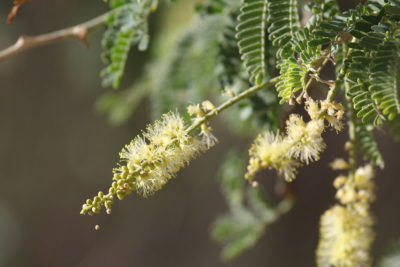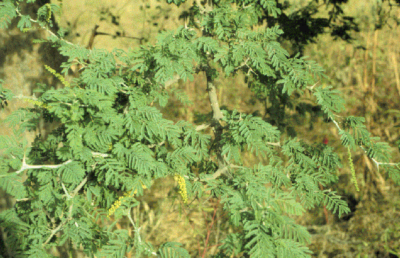
Faidherbia albida flower
by Roger Culos - Own work.
Licensed under CC BY-SA 3.0 via Wikimedia Commons
Ana tree is a thorny tree that is used in Africa for nitrogen fixation and erosion control. The wood is used to make canoes, mortars and pestles. The pods are used as a fodder for livestock.
Ana tree is a legume and can reach a height of 6 to 30 meters. It is very resistant to drought.
Names
Scientific
Faidherbia albida
Synonym
Acacia albida
English
Ana tree
Apple-ring acacia
Balanzan tree
Winter thorn
Dutch
Ana boom
Appel-ring acacia
Winter doorn
Spanish
Espina de invierno
French
Balanzan
German
Anabaum
Other
Ana
Taxonomy
Order
Fabales
Family
Fabaceae
Genus
Faidherbia
Species
Faidherbia albida (Ana tree)
Basic information and facts
Origin:
Africa and the Middle East
Distribution:
Africa and the Middle East
Evergreen or deciduous:
It is a deciduous tree with leaves present during the dry season, while it sheds its leaves in the rainy season.
Flowers:
Flowers of the Ana tree provide bee forage at the end of the rainy season.
Leaves:
The leaves are rich in nitrogen, and can be added to the soil as a natural fertilizer which can increase crop yields (e.g. maize).
Climate and weather:
Tropical savanna climate with wet and dry season.
Height:
The trees can be 6 to 30 meters tall.
Uses:
The trees are grown because they are legumes which can fix nitrogen. Leaves are added to soil as a natural fertilizer. Pods are used as fodder for livestock. The wood is used to make canoes, mortars, pestles, etc.
Ana trees can be planted between field crops because they shed their leaves during the rainy season and thus they don’t block the sunlight.
Crop categories
Arid crops
Forage and fodder crops
Green manures
Legumes
Minor crops
Subtropical crops
Timber
Tropical crops
Wild-harvested crops
Pictures

Ana tree - Photo by CDKNetwork

Faidherbia albida
by Marco Schmidt -
Own work (own foto).
Licensed under CC BY-SA 2.5 via Wikimedia Commons

"Faidherbia albida branch"
by http://edcintl.cr.usgs.gov/senegal2/veg1.html.
Licensed under Public Domain via Wikimedia Commons
